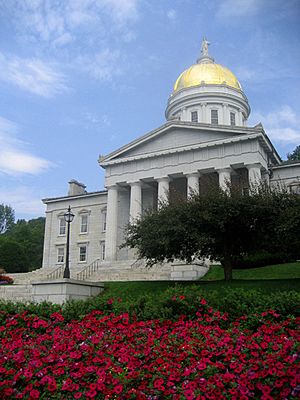Government of Vermont facts for kids

|
|
| Polity type | Presidential Republic |
|---|---|
| Constitution | Constitution of Vermont |
| Legislative branch | |
| Name | General Assembly |
| Type | Bicameral |
| Meeting place | Vermont State House |
| Upper house | |
| Name | Senate |
| Presiding officer | John S. Rodgers, President |
| Lower house | |
| Name | House of Representatives |
| Presiding officer | Jill Krowinski, Speaker |
| Executive branch | |
| Head of State and Government | |
| Title | Governor |
| Currently | Phil Scott |
| Appointer | Election |
| Cabinet | |
| Name | 7 Executive Agencies |
| Leader | Governor |
| Deputy leader | Lieutenant Governor |
| Headquarters | The Pavilion |
| Judicial branch | |
| Name | Judiciary of Vermont |
| Vermont Supreme Court | |
| Chief judge | Paul Reiber |
| Seat | Montpelier |
The government of Vermont is set up like a republic, similar to the Government of the United States. The Constitution of Vermont is the most important law in the state. It guides how the government works. This includes three main parts: the executive branch (which carries out laws), the legislative branch (which makes laws), and the judicial branch (which interprets laws).
All leaders in the executive and legislative branches serve two-year terms. This includes the governor and state senators. There are no limits on how many terms someone can serve. Vermont's state capital is Montpelier. Vermont became the fourteenth state to join the United States in 1791.
Contents
- Protecting Your Rights: Civil Rights and Liberties
- Making Laws: The Legislative Branch
- Carrying Out Laws: The Executive Branch
- Interpreting Laws: The Judicial Branch
- Managing Money: State Finances
- Local Government
- Connecting to the Nation: Federal Government
- Working Together: Joint Authority
- See also
- Images for kids
Protecting Your Rights: Civil Rights and Liberties
The Vermont Constitution gives many important rights to its citizens. It was adopted in 1793. Its first article, called "Declaration of the Rights of the Inhabitants of the State of Vermont," was very advanced for its time. It was written 14 years before the United States Bill of Rights.
This constitution made slavery and forced labor illegal. It also allowed all men to vote, even if they didn't own property. It protected religious freedom and kept government separate from religion. Many believe this "Declaration of the Rights" helped inspire France's Declaration of the Rights of Man and of the Citizen.
Making Laws: The Legislative Branch
Vermont's law-making body is called the Vermont General Assembly. It has two parts: the Vermont House of Representatives (the lower house) and the Vermont Senate (the upper house). Both meet at the Vermont State House.
The Senate has 30 state senators. The House of Representatives has 150 members. This means there is about one representative for every 4,059 people in Vermont.
Carrying Out Laws: The Executive Branch
The Executive Branch is led by the Governor of Vermont. It also includes many state agencies. This branch makes sure the state's laws are put into action and followed. The current Governor is Phil Scott, who is a Republican. The Governor's offices are in The Pavilion in Montpelier.
- Elected Executive Officers of Vermont
-
Governor Phil Scott (R)
People in Vermont vote for a state governor and a lieutenant governor separately. For example, if a governor leaves office, the lieutenant governor takes over. Besides the Governor and Lieutenant Governor, Vermonters also vote for four other statewide officials: the Secretary of State, State Treasurer, Vermont Auditor of Accounts, and Attorney General.
The executive branch is the largest employer in Vermont. It had about 8,000 employees in 2005. This is partly because Vermont's state government handles many jobs that county governments do in other states.
The executive branch is organized into different levels. At the top are secretaries and agencies. Below them are commissions, departments, and offices. There are seven main agencies, each run by an appointed secretary. These include:
- Administration
- Vermont Agency of Agriculture Food and Markets (Agriculture)
- Commerce and Community Development
- Digital Services
- Human Services
- Natural Resources
- Transportation
There are also many commissions, each run by an appointed commissioner. Some commissions are part of larger agencies. For example, the Tax Commission is part of the Administration Agency.
Interpreting Laws: The Judicial Branch
Vermont's highest court is the Vermont Supreme Court. It has five justices who serve six-year terms. The Chief Justice leads the court system and oversees all courts in Vermont. Vermont also has three other types of courts and one special division.
Judges for the Supreme Court, Superior Court, and District Courts are chosen by the governor. The governor picks from a list given by the state's Judicial nominating committee. The Senate then confirms these choices. After six years, the state legislature votes on whether to keep the judge.
- The Superior Court handles most major civil and criminal cases. It is the only court where you can have a jury trial.
- The Probate Court deals with things like wills, estates, adoptions, and name changes.
- The District Court hears cases about families, young people, minor crimes, and civil matters under $25,000.
- The Family Division handles cases like divorce, child custody, and domestic violence.
Vermont is one of twelve states that does not have the death penalty. An interesting part of Vermont's courts is the use of side judges. These are elected citizens who sit with the judge in some cases. They also help manage county affairs.
Managing Money: State Finances
Vermont is the only state that doesn't legally have to balance its budget. Yet, it has had a balanced budget every year since 1991. This means the state spends only as much money as it brings in.
Taxes in Vermont
Vermont collects different types of taxes to pay for state services.
- Income Tax: People pay a percentage of their income to the state. The more money someone earns, the higher percentage they might pay.
- Sales Tax: There is a 6% sales tax on most goods you buy. Some things are exempt, like food, medical items, and clothing. Some towns might add an extra 1% local tax.
- Property Taxes: These taxes are used to pay for schools and local services. They are based on the value of homes and other properties. Vermont does not tax personal items, but towns can choose to do so.
Vermont does not collect inheritance taxes. However, it does have its own estate tax on large estates after someone passes away.
State Lottery
Money from the Vermont Lottery helps pay for education. In 2007, it provided about 2% of the money spent on schools. Since 1998, all profits from the lottery must go towards education.
Local Government
County Government
Vermont counties have very few independent jobs. They mostly serve as boundaries for courts. Counties have elected officers like a State's Attorney and a Sheriff. Unlike other states, Vermont counties do not manage roads or other major services. The state directly funds county services through property taxes.
Municipal Government
Vermont has 254 municipalities, including ten cities, 237 towns, and five unincorporated areas. Towns are governed by citizens directly through town meetings. Between meetings, a selectboard or town manager handles town business. An elected town clerk keeps records and manages elections.
If a town grows too big for town meetings, it can become a city with a mayor and city council. Cities also have a board of aldermen instead of a selectboard.
Vermont has towns, cities, and villages. Towns are the main unit of local government. Cities are separate from towns. Villages are inside towns but handle some services like water or local roads. Vermont is the only New England state with incorporated villages. Almost all of Vermont is part of an incorporated municipality.
Connecting to the Nation: Federal Government
Vermont's state government does not take orders from the federal government. However, Vermonters elect people to represent them in the federal government. These representatives help make federal laws that affect Vermont citizens.
Congressional Delegates
Vermont has one member in the House of Representatives. Like all states, Vermont also has two senators in the US Senate.
| Chamber | District | Officer | Party | Term Start | Term Ends |
|---|---|---|---|---|---|
| Senate | At-Large | Peter Welch | Democrat | 2023 | 2029 |
| Bernie Sanders | Independent | 2019 | 2025 | ||
| House of Representatives | At-Large | Becca Balint | Democrat | 2023 | 2025 |
Federal Courts
Federal court cases in Vermont are handled in the United States District Court for the District of Vermont. Decisions from this court can be reviewed by the Second Circuit Court of Appeals in New York City. The President nominates federal judges and attorneys, and the Senate confirms them.
Working Together: Joint Authority
Some agencies are run by both the Legislative and Executive branches. One example is the Vermont Telecommunications Authority. Its goal is to make high-speed internet available to everyone in Vermont.
See also
- Politics of Vermont
- Elections in Vermont
- Judiciary of Vermont
- Impeachment in Vermont
Images for kids
-
Governor Phil Scott (R)














